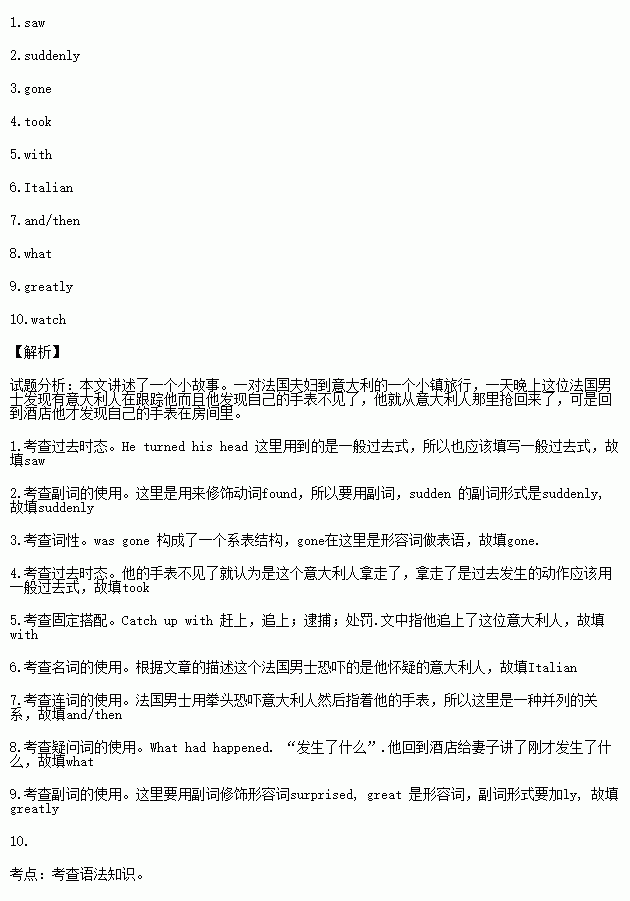题目内容
A Frenchman went to a small Italian town and staying with his wife at the best hotel there. One night, he went out for a walk alone. It was late and the small street was dark and quiet. Suddenly he felt someone behind him.He turned his head and 1.(see) an Italian young man who quickly walked past him. The man was nearly out of sight when the Frenchman 2.(sudden) found that his watch was 3. (go). He thought that it must be the Italian who 4.(take) his watch. He decided to follow him and get back the watch.
Soon the Frenchman caught up 5. the Italian. Neither of them understood the other’s language. The Frenchan frightened the 6.with his fist 7. pointed at the Italian’s watch. In the end the Italian gave up his watch to the Frenchman.
When he returned to the hotel, the Frenchman told his wife 8. had happened. He was 9.(great) surprised when his wife pointed to the 10. on the table. Now he realized that by mistake he had robbed the watch and it was the Italian’s.
 阅读快车系列答案
阅读快车系列答案Use For Use for mechanically generated dusts, mists from processing minerals including coal, iron ore, silica, cotton, flour and certain other substances in concentrations up to ten times the Occupational Exposure Standard or according to local regulations. Do Not Use For Do not use for paint spraying and sandblasting applications or for protecting against gases and vapors. Do not use in atmospheres containing less than 19.5% oxygen, as this respirator does not supply oxygen. Not for use in oil mist atmosphere. Use Limitations 1. The wearer must first be trained in the proper use and fit tested before using this respirator. 2. Do not use this respirator when concentrations of contaminants are immediately dangerous to life or health. 3. Leave the contaminated area immediately if breathing becomes difficult, or dizziness or other distress occurs. 4. Discard and replace respirator if it becomes damaged or breathing resistance becomes excessive. 5. Inspect respirator before each use to ensure it is in good working condition. 6. Do not alter, wash, abuse or misuse this respirator. 7. Do not use with beards or other facial hair or other conditions that prevent a good seal between the face and the sealing edge of the respirator. 8. Can be used up to the limits specified by applicable government regulations for this product. 9. Failure to follow all instructions and warnings on the use of this respirator and/or failure to wear this respirator during all times of exposure can reduce respirator effectiveness and may result in illness or permanent disability 10. Maximum operating temperature: +50°C. Caution Care should be taken when using the product at low temperatures as excessive moisture may cause alves(呼吸阀) to freeze. Storage Conditions and Shelf Life Shelf life of unopened product is 5 years from date of manufacture when stored within temperature range of -20°C to +30°C and at less than 80% relative humidity. Warning This respirator helps protect against certain particles. Misuse can result in sickness or death. For proper use, see supervisor or user instructions in the box or contact 3M Co. Ltd. |
1.The passage mainly tells us _________.
A. what this product is
B. why should we buy this product
C. how to protect us against dusts and mists
D. how to use and store the product properly
2.What is the meaning of the underlined word “respirator” in Paragraph 2?
A. Glasses.
B. Face mask.
C. Protective gloves.
D. Protective clothing.
3.In which condition can this product be stored?
A. Temperature: 50°C; Humidity: 40%
B. Temperature: 50°C; Humidity: 80%
C. Temperature: 25°C; Humidity: 40%
D. Temperature: 25°C; Humidity: 80%

